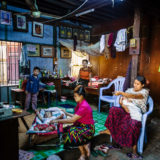

The Young Mason
Mandalay holds the title of the second largest city in Myanmar, as well as the last royal capital of the country when the Konbaung Dynasty ended towards the end of the 19th Century. In addition, this vibrant city is also considered to be the Buddhism capital of the world, making it a truly magical place where crafts and hand skills are still very much prevalent.
I met this man while he was working tirelessly as a stone mason producing numerous Buddha statues. These young men are an intrinsic part of the traditional and less developed areas in the Southern Hemisphere of the world, as they are the primary breadwinners that often support large families consisting of several children and elderly people.
And yet, while the people in Mandalay have a certain poise and dedication to their craft, there is a very faint hint of change in the air. The city appears to be a place that exists in an eternal state of trance, where visitors from the outside are still perceived as being messengers from another distant world.
However, the young men of Mandalay still feel a deep-rooted yearning to seek out new and better possibilities, but their situation is compounded by an insecure future that is ripe with fear of new challenges and the unknown. Some of these individuals do actually venture out of Mandalay, and end up forming part of the convoy of refugees that leave Myanmar to the west and the north.
This portrait epitomises the fundamental social, personal, and political issues that citizens of Mandalay have to grapple with, by focussing on the challenging lives young men in this city lead.


No Comments on This Post